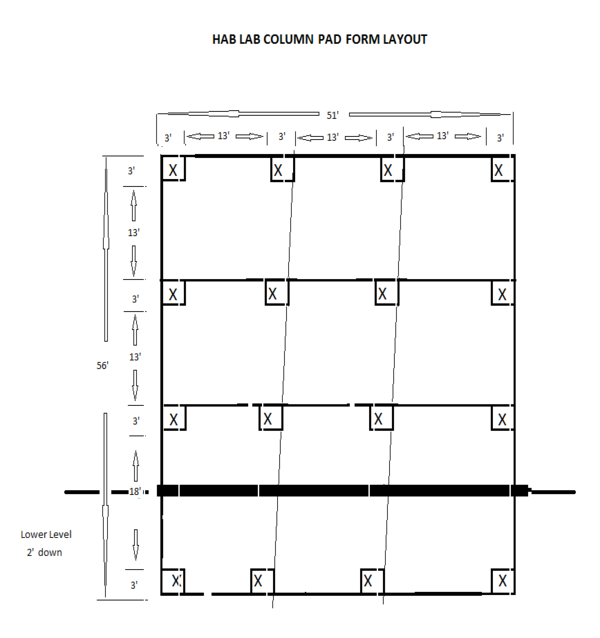How Not To
In every project there are caveats that should be heeded and have been discovered by those who have attempted something similiar. When do-it-yourselfers pull a real boner and mess things up, it can be pretty embarrassing and their first response may be to gloss it over in their reports. However - especially in the case of Open Sourse work, where the idea is to help others be able to do the same project - our errors can be others' most valuable resource! On this page, we swallow our pride, report and analyze our errors, tell what we did for damage control and the results, and make strong recommendations for ways to avoid the mistake.
Hab Lab
Well, as I understand it, the 'lab' part of the name indicates that it is a laboratory - a place where we experiment and learn. Here are some of the How Not To things we learned during this building experiment.
Laying out the locations for the forms on top of the foundation stone
One problem led to another one:
First
We had a great plan for this - we would set our stakes out first to mark the hole edges at 4'x4', save the strings and move the stakes in by 6" to 3'x3' for setting the pad forms.
What happened
- We lost a lot of our stakes during the excavation.
- We found the holes tended to come out bigger than we had intended them to be.
- And once the stone was laid over the site, we couldn't see where the foundation holes were located!
Damage control
We wound up remeasuring and resetting most of the stakes for laying out the pad site grid.
- We dug stone out of two of corners to find the edges of the foundation holes.
- We remeasured and reset corner marking stakes inside those edges.
- We retriangulated with the diagonals to assure the foundation square.
- And we remeasured and reset stakes along all the edges.
Avoiding the problem
So we've rewritten the foundation lay-out plans as they are currently posted. In the current version, we
- Set the stakes firmly and safely outside the excavation area,
- Set them at the 3'x3' points to start with so they don't need to be moved, and
- Marked the excavation holes smaller.
Second
We started setting the floor and wall forms and found that our East row of firmly-set-concrete column pads were sitting 3' further South than they should have been! Further observation determined that two entire East/West rows were affected by the error.
What happened
First
- The outlining strings for the site were set properly and square - good.
- However, while doing all of the fixing for the first problem, we got tired and thought up a short cut. We were short on stakes and we needed to mark both the hablab and the workshop sites for form placement (our 40 forms would require us to locate and put in some 40 stakes) We could place our forms easily enough in line with the strings with only one corner marked couldn't we? (That would require placing half as many stakes!)
- We started at the NorthWest corner and measured 16' East along the North line and staked that for a line. Then another 16' East we set another stake.
- Then we went back and did the same from the NorthWest corner to the South. - and from the SouthWest corner to the East.
- Finally we went down to the lower level and marked the East line of the site starting at the South end of the line. - And we ran our strings.
Then, later
- Time constraints were closing in on us.
- We were tired 'and' losing daylight when we set the forms in place along the lines on the Hab Lab site.
- We had some difficulty lining up some of the forms squarely with the marking strings.
Damage Control
We decided that an emergency floor plan change we came up with should compensate for this without having to redo most of the column pads. So this is the layout we are actually working with now!
Avoiding the problem
I don't recommend using this short cut, but if you do:
- Check and recheck the measurements on string placements. -Measure twice, cut once is how they say it in carpentry.
- Make time in your schedule to really focus on the project - and look at the results.
- Work in the daylight hours
- Look for a cause when anything is more difficult than it should be - It was hard to align the squarely built pads with the strings (that should have been crossing at right angles) for a good reason!
